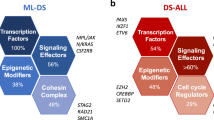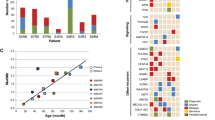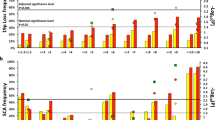Abstract
Neuroblastomas frequently have deletions of chromosome 1 p and amplification of the N–myc oncogene. We analysed 53 neuroblastomas for the N–myc copy number, loss of heterozygosity (LOH) of chromosome 1 p36 and the parental origin of the lost alleles. Allelic loss of 1p36 was found in 15 tumours. All N–myc amplified tumours belonged to this subset. In 13/15 tumours with LOH of 1 p36 the lost allele was of maternal origin. This non–random distribution implies that the two alleles of the putative neuroblastoma suppressor gene on chromosome 1p36 are functionally different, depending on their parental origin. This is the first evidence as far as we know for genomic imprinting on chromosome 1p.
This is a preview of subscription content, access via your institution
Access options
Subscribe to this journal
Receive 12 print issues and online access
$209.00 per year
only $17.42 per issue
Buy this article
- Purchase on Springer Link
- Instant access to full article PDF
Prices may be subject to local taxes which are calculated during checkout
Similar content being viewed by others
References
Brodeur, G.M. et al. Neuroblastoma; effect of genetic factors on prognosis and treatment. Cancer 70 Supplement, 1685–1694 (1992).
Fong, C.T. et al. Loss of heterozygosity for chromosome 1 or 14 defines a subset of advanced neuroblastomas. Cancer Res. 52, 1780–1785 (1992).
Weith, A. et al. Neuroblastoma consensus deletion maps to 1p36.1-2. Genes. Chromosom. Cancer 1, 159–166 (1989).
Devilee, P. et al. Frequent somatic imbalance of marker alleles for chromosome 1 in human primary breast carcinoma. Cancer Res. 51, 1020–1025 (1991).
Leister, I. et al. Human colorectal cancer: high frequency of deletions at chromosome 1p35. Cancer Res. 50, 7232–7235 (1990).
Dracopoli, N.C. et al. Loss of alleles from the distal short arm of chromosome 1 occurs late in melanoma tumour progression. Proc. natn. Acad. Sci. U.S.A. 88, 4614–4618 (1989).
Moley, J.F. et al. Consistent association of 1p loss of heterozygosity with pheochromocytomas from patients with Multiple Endocrine Neoplasia type 2 syndromes. Cancer Res. 52, 770–774 (1992).
Mannens, M.M.A.M. et al. Molecular nature of genetic changes resulting in loss of heterozygosity of chromosome 11 in Wilms' tumours. Hum. Genet. 81, 41–48 (1988).
Schroeder, W.T. et al. Non-random loss of maternal chromosome 11 alleles in Wilms' tumours. Am. J. hum. Genet. 40, 413–420 (1987).
Pal, N. et al. Preferential loss of maternal alleles in sporadic Wilms' tumour. Oncogene 5, 1665–1668 (1990).
Scrable, H. et al. A model for embryonal rhabdomyosarcoma tumorigenesis that involves genomic imprinting. Proc. natn. Acad. Sci. U.S.A. 86, 7480–7484 (1989).
Toguchida, J. et al. Preferential mutation of paternally derived RB gene as the initial event in sporadic osteosarcoma. Nature 338, 156–158 (1989).
Sapienza, C. Genome imprinting and carcinogenesis. Biochim. Biophys. Acta 1072, 51–61 (1991).
Hall, G.H. Genomic imprinting: review and relevance to human diseases. Am. J. hum. Genet. 46, 857–873 (1990).
Reik, W. Genomic imprinting and genetic disorders in man. Trends Genet. 5, 331–336 (1989).
Dryja, T.P. et al. Parental origin of mutations of the retinoblastoma gene. Nature 339, 556–558 (1989).
Stephens, K. et al. Preferential mutation of the neurofibromatosis type 1 gene in paternally derived chromosomes. Hum. Genet. 88, 279–282 (1992).
Zhu, X. et al. Preferential germline mutation of the paternal allele in retinoblastoma. Nature 340, 312–313 (1989).
Leach, R.J. et al. Preferential retention of the paternal alleles in human retinoblastoma: evidence for genomic imprinting. Cell Growth Diff. 1, 401–406 (1990).
Kushner, B.H., Gilbert, F. & Helson, L. Familial neuroblastoma;case reports, literature review, and etiologic considerations. Cancer 57, 1887–1893 (1986).
Knudson, A.G. & Strong, L.C. Mutation and cancer: Neuroblastoma and pheochromocytoma. Am. J. hum. Genet. 24, 514–532 (1972).
Clausen, N., Andersson, P. & Tommerup, N. Familial occurrence of neuroblastoma, von Recklinghausen's neurofibromatosis, Hirsprung's aganglionosis and Jaw-winking syndrome. Acta Paediatr. Scand. 78, 736–741 (1989).
Robertson, C.M., Tyrrell, J.C. & Pritchard, J. Familial neural crest tumours. Eur. J. Pediatr. 150, 789–792 (1991).
Surani, M.A., Reik, W. & Allen, N.D. Transgenes as molecular probes for genomic imprinting. Trends Genet. 4, 59–62 (1988).
Hoovers, J.M.N., Dietrich, A.J.J. & Mannens, M.M.A.M. Imprinting and the Beckwith-Wiedemann syndrome. Lancet 339, 1228 (1992).
Versteeg, R. et al. N-myc expression switched off and class I human leucocyte antigen expression switched on after somatic cell fusion of neuroblastoma cells. Molec. cell Biol. 10, 5416–5423 (1990).
Ellmeier, W., Aguzzi, A., Kleiner, E., Kurzbauer, R. & Weith, A. Mutually exclusive expression of a helix-loop-helix gene and N-myc in human neuroblastomas and in normal development. Embo J. 11, 2563–2571 (1992).
Evans, A.E., d'Angio, G.J. & Randolph, J. A proposed staging system for children with neuroblastoma. Cancer 27, 374–378 (1971).
Müllenbach, R., Lagoda, P.J.L. & Welter, C. An efficient salt-chloroform extraction of DNA from blood and tissues. Trends Genet. 5, 391 (1989).
Feinberg, A.P. & Vogelstein, B.A. A technique for radio labeling DNA restriction endonuclease fragments to high specific activity. Annal. Biochem. 137, 266–267 (1989).
Schwab, M., Alitalo, K. & Klempnauer, K.H. Amplified DNA with limited homology to myc cellular oncogene is shared by human neuroblastoma cell lines and a neuroblastoma tumour. Nature 305, 245–248 (1983).
Derom, C. et al. Zygosity determination in newborn twins using DNA variants. J. med. Genet. 22, 279–282 (1985).
Lauthier, V., Mariat, D. & Vergnaud, G. CEB15 detects a VNTR locus (het:92%) on chromosome 1p. Hum. molec. Genet. 1, 63 (1992).
Dracopoli, N.C. et al. The CEPH consortium linkage map of human chromosome 1. Genomics 9, 686–700 (1991).
Author information
Authors and Affiliations
Rights and permissions
About this article
Cite this article
Caron, H., van Sluis, P., van Hoeve, M. et al. Allelic loss of chromosome 1p36 in neuroblastoma is of preferential maternal origin and correlates with N–myc amplification. Nat Genet 4, 187–190 (1993). https://doi.org/10.1038/ng0693-187
Received:
Accepted:
Issue Date:
DOI: https://doi.org/10.1038/ng0693-187
This article is cited by
-
Collateral lethality between HDAC1 and HDAC2 exploits cancer-specific NuRD complex vulnerabilities
Nature Structural & Molecular Biology (2023)
-
Chromosome 1p status in neuroblastoma correlates with higher expression levels of miRNAs targeting neuronal differentiation pathway
In Vitro Cellular & Developmental Biology - Animal (2023)
-
dsPIG: a tool to predict imprinted genes from the deep sequencing of whole transcriptomes
BMC Bioinformatics (2012)
-
LIN28B induces neuroblastoma and enhances MYCN levels via let-7 suppression
Nature Genetics (2012)



